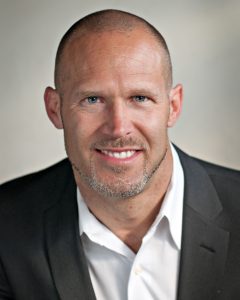Anatomy of an Era: Final Chapter/THE COACHING STAFF

Excerpted from Chapter 104, No Place Like Nebraska: Anatomy of an Era, Vol. 2 by Paul Koch
Anatomy of an Era: Final Chapter/THE COACHING STAFF
There is a time in every man’s education when he arrives at the conviction that envy is ignorance; that imitation is suicide; that he must take himself for better, for worse, as his portion; that though the wide universe is full of good, no kernel of nourishing corn can come to him but through his toil bestowed on that plot of ground which is given to him to till…
-Ralph Waldo Emerson, Self Reliance
Well, folks, I’ve tilled my plot and -in reference to Emerson’s words above- tried my level best to arrive at a place opposite ignorance as it pertained to the historic run by Nebraska Football in the mid-1990’s. After all the efforts, now is the harvest of an education and a satisfying meal of enlightenment. After a lengthy span of conversational information gathering, a full winter season spent digesting, comprehending, deliberating, apprehending, and mulling over in my mind how all of the puzzle pieces linked up with each other; how one’s action here, a second’s idea there, and yet a third’s spoken word elsewhere eventually snowballed into such a grandiose sporting accomplishment: the five fall seasons’ 60 & 3 Cornhusker Football won-loss record.
And suddenly -like Cupid’s fleet arrow- it all came together in my head about the stroke of midnight on a Valentine’s Day. Almost three years to the day of embarking on a quest to grasp a complete, exhaustive and most authoritative understanding of the Great Nebraska Football 60 & 3 Why and How, it all finally made crystal clear sense how everything fit into place: how a great Colossus of individuals and ideals coalesced into one grand, unified recipe for success. Call it inspiration, call it understanding, call it an epiphany, call it what you may, but it finally appeared in my mind’s eye how to most accurately portray this oral mosaic possessing the full array of a rainbow’s spectrum into one prism of thought. It was that one ‘Aha! Moment’ for me. ‘Eureka!’, as if I were the great Archimedes, ‘…I’d found it!’ Truth be told, ‘How’ it happened was the easy bit; but it was the ‘Why’ of that era’s Husker greatness that had befuddled me for a spell. This no longer the case, now it was only a matter of putting everything down on paper.
Given the information available to me from the most reliable of sources –those who lived it out and shared with us their histories in the preceding pages- what you read here is the culmination of our memorable journey’s N Factor List. One can imagine how it all comes together. Perhaps a surprise or two still remains in store for you, though. And that’s half the fun of it, wouldn’t you agree?
So, without further delay we’ll launch first into ‘How’ that era of dominance transpired and then wrap up our time together by revealing ‘Why’ this thing of college football beauty came to be. Here is the skinny, dear reader, patched together like a country quilt. Like a seamstress, I borrow heavily from and arrange the many participants’ own words as a testimony to the detailed summation’s authenticity. It’s a beautiful view from up here on top of the Memorial Stadium. So take a deep, cleansing breath. Breathe it all in, and savor the sounds, the sighs, the sights, and the heights to which the Huskers soared in that magnificent era of unified 60 & 3 dominance.
HOW the Great 60 & 3 Success was achieved:
THE COACHING STAFF
It would be a mistake to begin with anything but the football coaching staff, because they not only found out and recruited the young student-athletes to campus, but then proceeded to instruct, coach, motivate, counsel and mentor them. This was not a task for the lazy nor the faint-hearted. Who exactly were these men and what kind of dynamic existed among them? It all started at the top, and the first thing we found was that Tom Osborne did not assemble a self-same crew:
Tom (Osborne) did an excellent job in recruiting and keeping this staff and having quite a bit of diversity, and they related extremely well to the student-athlete. – Al Papik
There was a common theme with a lot of the coaches at the time when you look at (Dan) Young, (Milt) Tenopir, Charlie McBride. You had these guys who were gonna rip you if you screwed up in practice -absolutely rip you a new one- but at the end of the practice they were still the guy you wanted to go up and give a hug to. Like I said, it’s hard to find guys like that. – Rob Zatechka
…there was fire & ice in that crew. – Mark Cisco
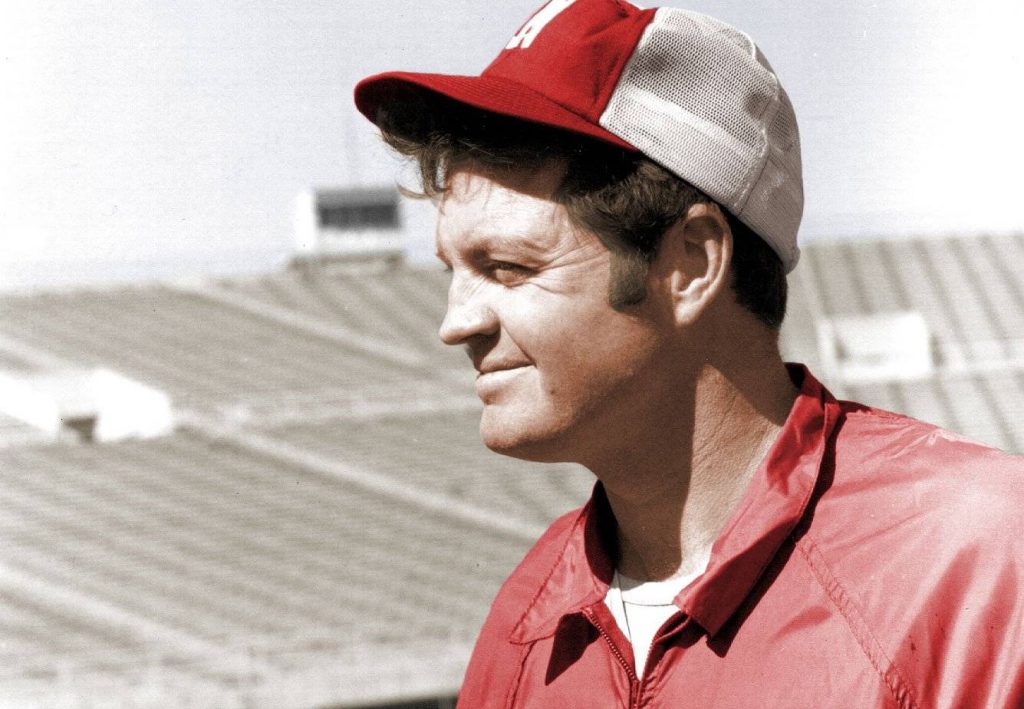
Tom Osborne, March 1973
Who were all of one mind, one accord as to how the team functioned…
All the coaches, top to bottom, had their own personal style, but they had one common goal and they all knew what they were doing from top to bottom. – Aaron Taylor
It just flowed so smoothly because of the people like Charlie (McBride) and Tony (Samuel) and George (Darlington) being such great leaders. There was no egos. None, in no way, shape or form. – Clayton Carlin
We all knew each other 100 years, you know what I mean? And everybody would sit down and kind of look at the film and talk over things we wanted to do, and then we’d go out to practice… It prevented a lot of arguments about every little thing. Same philosophy on a lot of things, which helps. – Tony Samuel
…all the coaches were all on the same page. You never had one coach saying one thing and another coach saying another thing. They all had a system and they all believed in that system, and there was no deviation from your coach… The assistants, especially with the offensive linemen, I can’t think of a word that described the offense line more than the word ‘consistent.’ – Zach Wiegert
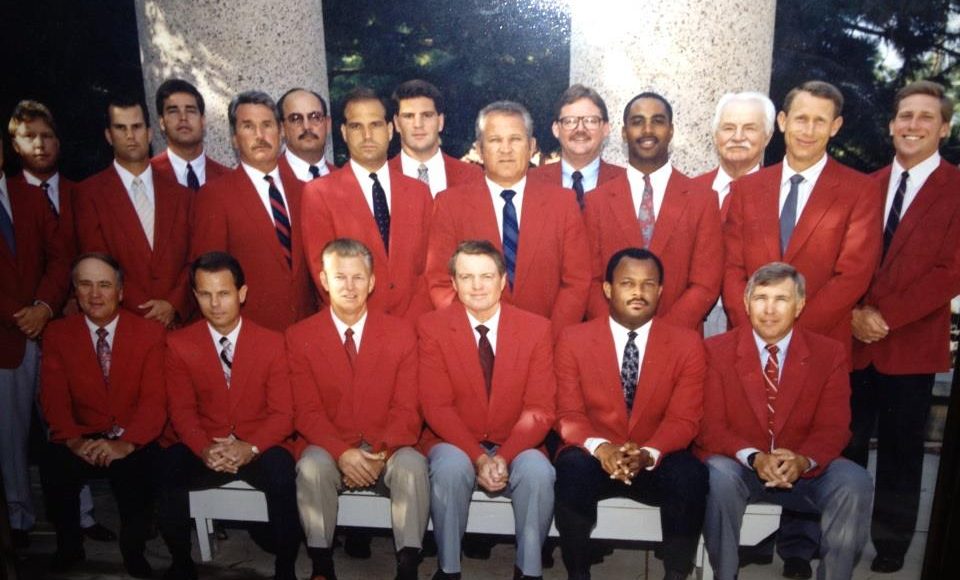
Who generally practiced a very positive & encouraging teaching style…
I’d never seen any negativity from our staff. The program was an A-type program. I’m talking about Tom all the way down to every assistant coach to the players. There was nothing negative. I’d hear things from other schools and I wondered how that could be, because I’d never witnessed anything negative in our program… All the coaches had a lot to share… – Corey Dixon
Whether we were down by seven or down by ten, “Let’s just focus on what we have to do and everybody do their job, and we’ll be alright.” (Osborne) talked in such a calm nature, and he would say that, “We need to get back to the basics and everybody execute the play and you do your job. Everybody do their job and we‘re gonna be fine.” And that’s how he was, very calm, and talking it through for people. Even if some people were frustrated because they missed a block or missed a run or dropped a ball, you know what I mean? He would be very encouraging, “You’re going to get that next time.” And not be down on a player. – Damon Schmadeke
Kevin Steele was a great coach, but he was really one of those high energy personalities, always on the go. I remember one time he kind of slipped and let out some profanities around these high school students, and I remember Tom going, “Hey Kevin, come here.” And he said this in front of everybody, he said, “I don’t ever want to hear you talk to a guy like that. You can get your point across without talking to a guy like that.“ And Kevin said, “Okay, Coach. I’m sorry.” And Tom was, “No, there’s no need to apologize. Just make sure it doesn’t happen again.” – John Reece
Coach Osborne had no tolerance for coaches who undressed players on the sideline. I’m not saying that a coach didn’t get after you; I had my fair share of Charlie McBride grabbing my facemask and chewing tobacco being spit in my face as he was yelling at me, (laughs) but I was a young player and they were mental mistakes, mental-type things. – Trev Alberts

Despite differing personalities and temperaments, they found a way to co-exist…
Looking back, the thing that strikes me about that staff was how unique the personalities were. You didn’t have coaches who were all -how do I say this?- stereotypical. They were not all ex-jocks, or the prototypical football coaches who yelled a lot and all that stuff, but you had all different personalities. From Tom (Osborne), and then you had Milt Tenopir and Dan Young as the offensive line coaches and kicking coach: they couldn’t have been more laid back. Their personalities could not have meshed better with the guys that they coached…(Tom Osborne) had great respect for his coaches and allowed them to do their jobs, and they in turn had tremendous respect and reverence for Tom Osborne and the way he treated them. And that dynamic… to witness that dynamic for a couple of decades was phenomenal. – Bill Doleman
…all those guys, it was a family atmosphere. There was a cohesiveness and chemistry that was there. And I remember Coach Ron Brown talking about it. Here’s a bunch of these coaches that had been there forever and just understood -not only Coach Osborne’s philosophy, but each other. –Brenden Stai
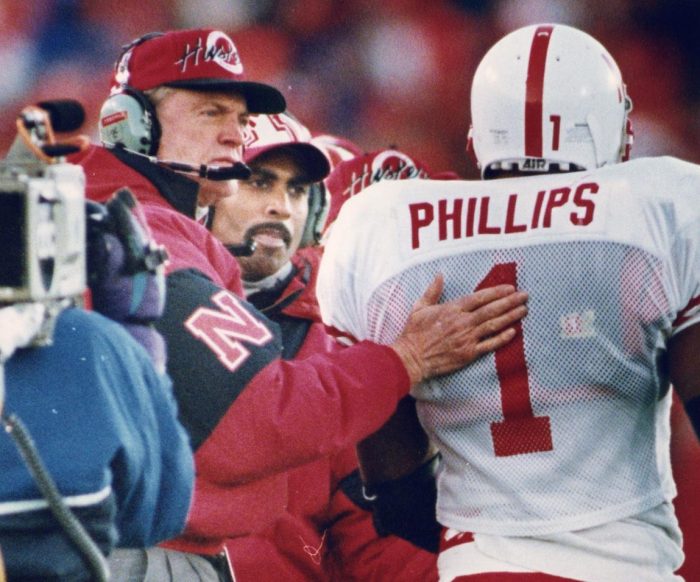
Most were very effective communicators…
…all the coaches -outside of Kevin Steele- were all extremely fair. They were just a real fair bunch of guys. They never really showed any favoritism, per se. Even if you weren’t the marquee player or just kind of the average white guy like I was, they treated you respectfully and treated you fair.
– Jon Pederson
…they did a great of job of teaching during the week and then just letting us perform during the games. – Trev Alberts
I always knew what kind of attitude (Coach Tenopir) was in, because we’d always start practice off with our 2 o’clock film sessions. We’d always meet and do a team briefing with Coach Osborne and all the coaches, and then we’d split up and do our breakout sessions and the O-linemen would go into Milt’s office. And when you walked in he’d be calling the guys by their names. If he called me ‘Pruitt’ he was pissed off. If he called me ‘Pru’ he was in a pretty good mood, and if he called me ‘Bryan’ he was in a real good mood. – Bryan Pruitt
They knew how to push buttons for sure, using their expectations as a standard of measurement rather than performance against weaker or under-performing opponents…
…when we were in a close game all the coaches were all calm and collected and, “Alright, you’re doing good.” And when we were blowing somebody out, flipping McBride was spittin’ and screaming and chewing somebody out and Osborne’s freaking out. It was like, ‘What the hell is going on?!’ (laughs) It was hilarious. – Phil Ellis
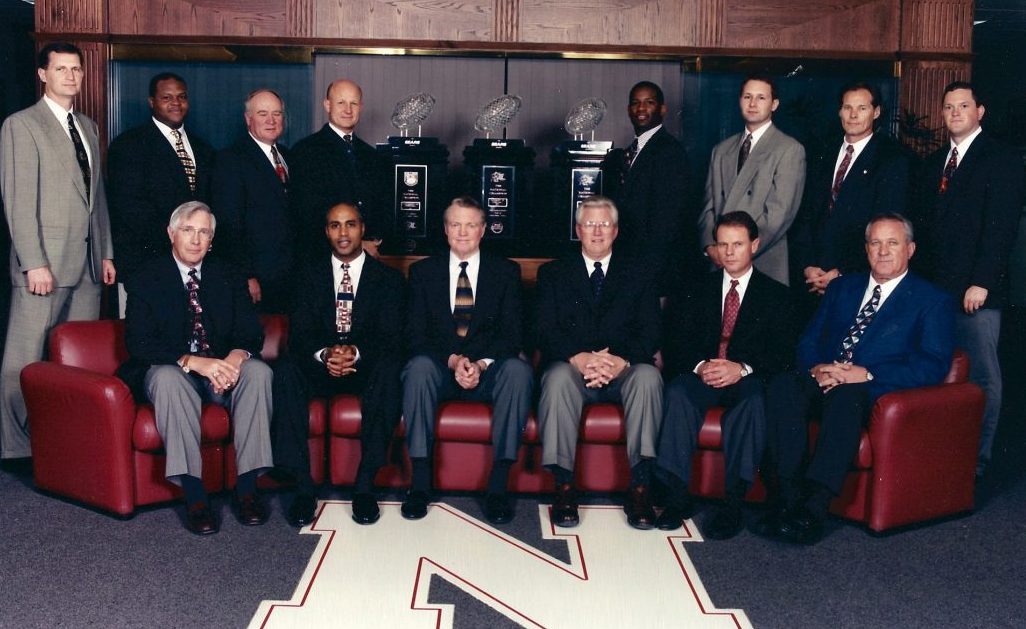
As a whole -and this is very important- the coalition had few peers when it came to mid-game adjustments…
…we had enough experience as a staff and had enough institutional knowledge to draw on that we could think about maybe what we had done when something like that had happened four years before, five years before. So I think we were a staff that was able to adjust during a game quite well. – Tom Osborne
(Osborne) had a lot of the plays he called memorized and he would just put a complete game together. And the adjustments that he would make on the fly? I don’t know if there is another coach that made the type of adjustments that Coach Osborne made during the game… I remember the Missouri game. He told us, “Just keep playing, keep fighting.” Like the Miami game, that halftime speech. He said, “We’re gonna keep hitting them in their mouth and they’re gonna break.” And that actually happened. – Vershan Jackson
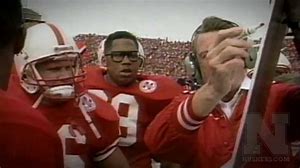
…if something wasn’t working they made adjustments at halftime and completely switched things around if we needed to, and that’s what worked and got it done. And I think that’s a bigger talent than what people really know. – Jared Tomich
…that was another thing: continuity and camaraderie, that goes a long way… they had such an unbelievable system, we could out-scheme anybody in America because they’d done it so long. And then you get on out on the game field and see what the other team is doing? Just the ability to make adjustments at halftime and during the game… – Ryan Held
They sought input directly from the players themselves…
I’ve never seen coaches who could adjust to situations like they could. We’d go three plays and out and Coach Solich would be talking to you and talking to Coach Osborne and, “What’s going on? What are we seeing in there?” And I tell you what, the whole next series had a whole different blocking scheme and we’re running different plays. That’s why I feel so honored to have played with that coaching staff, because you don’t find that. It’s hard to find a coaching staff who can make adjustments after three plays and out. Most coaches can’t make adjustments at halftime. – Calvin Jones
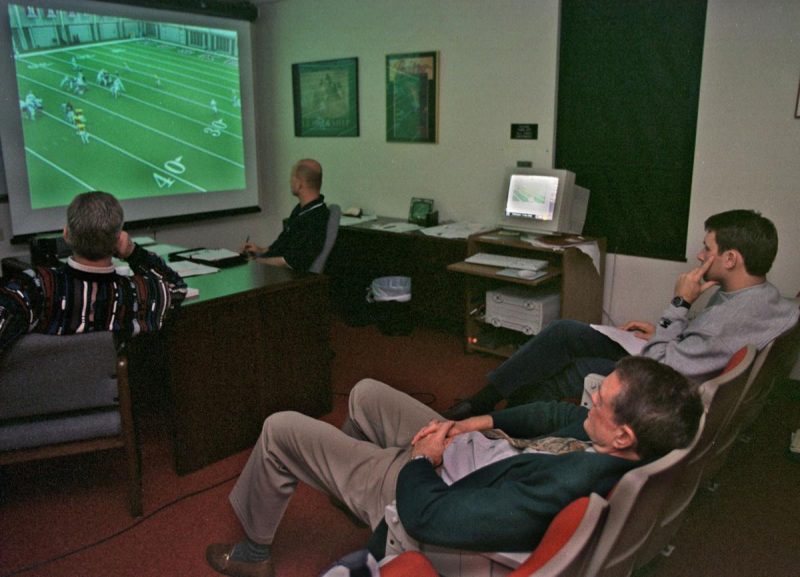
They were film-room junkies…
…the position coaches for each position would watch an amazing amount of film, day in and day out. Coach Osborne would have a game plan laid out before the game even started, he always knew what the first play was that he was going to call. Do you remember that? …Those guys, they put time in from sun-up to sun-down and then some. – Jon Pederson
As for keeping the pulse of the student-athlete, they were concerned with more than merely what happened on the playing field…
…sitting in the meeting room with all the coaches, we would discuss the players. And it would blow me away each Monday with how much the coaches knew about what the players did that past weekend. They were like, ”Did you hear about this guy…?” I was like, ‘How did they know this stuff?’ If you sneezed, they knew. (laughs) They know more than you think they know, if you’re in trouble with school or skipping class or failing a class… it was really interesting to sit in there and hear what they would know about you and how much they knew about you: off-field and on-field issues, girl issues, classes. I think that was the way Coach Osborne was. He was always looking out for your best interests and making you a man.– Damon Schmadeke
The worst thing you ever wanted to do was go to the Unity Council because you missed class. I learned that right away, because even as a ‘Prop’ Coach Osborne signed me up for that gig, so they were checking me just like they were checking everybody else. So they cared. Coach Osborne and Coach McBride, the whole organization, you felt like they cared. And it wasn’t even about whether or not you were going to be a great player, it was whether…you were going to go out and be a positive influence in the world. – Jared Tomich
As for ‘institutional control’, even the Head Coach was not hesitant to venture from his office to perform a checkup on campus classrooms…
I remember several times Coach Osborne had come over to see if one of the students was in their class, because he was upset. We used to give little notes, we used to fill them out for the athletic department, “Is so and so attending class?” And I’d put down, I’d say, ‘So and so has only been here once or twice in the last month,’ and then I wondered what was going to happen to the poor kid. And the next thing I know I see Tom Osborne in the back of the room because he’d told this kid, “You’re either going to get with it or you’re not going to be on the team.” – Professor Kenneth Dewey
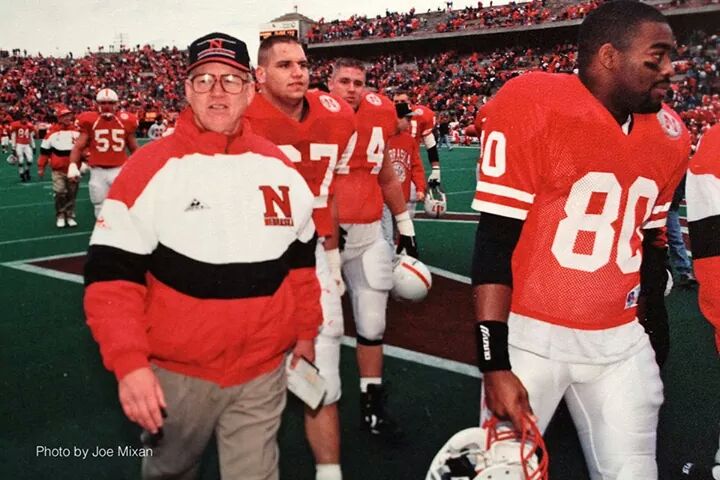
Nor was he lax to sever ties with boys behaving badly…
Osborne called my parents and I into a meeting on a Sunday morning after I’d been arrested downtown and he basically said, “I’m taking Kevin’s scholarship away. He can’t continue to do this. We’ve given him chances, he keeps messing up..” and he looked at me and he apologized to me. He said, “I’ve failed you. But I promise you one thing, you will graduate from this university and you will be an asset to this community. But I’m telling you right now, you’ll never play on that field again.” – Kevin Ramaekers
And basically Coach Osborne told (Lawrence Phillips), “You are to respect her. She is a coach just like we are. And if you ever do that again you will find yourself not on this team anymore. Because we want you on the team, but we can have a team without you.” – Sonya Varnell
Osborne said, “Guys, I’m kicking (Lawrence) off the team. He’s gonna have to get this counseling. If you want him off the team he’s off the team for good.” And this is why I admire the man so much, because he took a lot of heat for the deal.”If you want him off the team, he’s off the team. If you want him back on the team, I need some rules and regulations that you want out of him on top of what I’m gonna make him do, and this is what I’m going make him do: X,Y,Z…” And he ended up saying, “If he misses anything I require him to do, he’s done. Let me know what you decide.” He left and we sat there and talked about it… – Aaron Taylor
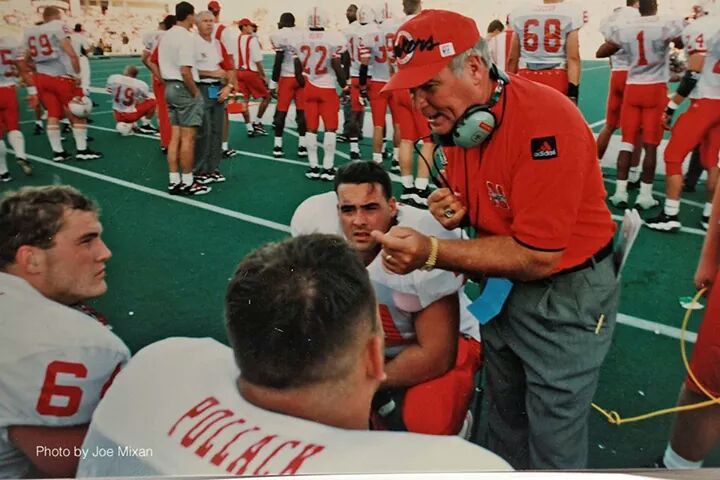
Shedding some light on the staff dynamic in this opening salvo, we’ll delve deeper into each individual on the coaching staff next, as we talk about the offense and defense. In general, it’s safe to say that the group was a cohesive one and a varied one when it came to temperaments, dispositions, coaching & leadership styles, ages & ethnicities, as well as communication styles. What they did have in common, though, was this: a passion for developing young men and making the most of their time as student-athletes on the Nebraska campus. Each one could probably write an entire memoir replete with methods, tales, tools of the trade, and the talents that they taught. In the limited space we have here, though, we’ll continue to focus more on the effects of their instruction and the lasting impressions they made.
Summary Chapter to be continued…..
Copyright @ 2013 Thermopylae Press. All Rights Reserved.
Photo Credits : Unknown Original Sources/Updates Welcomed
Author assumes no responsibility for interviewee errors or misstatements of fact.
